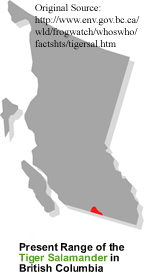
The Tiger Salamander (Ambystoma tigrinum) is the largest land-dwelling salamander on Earth, currently listed as endangered by COSEWIC and red-listed in British Columbia, Canada (National Geographics). The focus of this project is on the blotched or northern Tiger Salamander (A. tigrinum melanostictum) the only sub-species that occur in a limited habitat range of BC’s “pocket desert” near Oliver (Cannings 1996, SOCS). Its limited habitat range within Canada is largely due to its very strict habitat criteria, requiring a hot, semi-arid climate, slow moving water bodies or alkaline ponds for breeding and burrows of grassland rodents (Ministry of Environment – Website, SOCS). Tiger Salamanders are often found in burrows under grassland habitats characteristic of antelope bitterbrush and bunchgrasses within the bunchgrass and ponderosa pine biogeoclimatic zones (SOCS). These salamanders are carnivorous, feeding on other aquatic or terrestrial animals such as worms, insects, tadpoles, baby mice and frogs (SOCS). Other important information to note is the different lifestages of the tiger salamander where some will remain in aquatic form while others will take on the terrestrial form ( SOCS).
 The purpose of this project is to explore and display areas of varying suitability for the Tiger Salamander throughout the south western Okanagan between Oliver and Osoyoos. The importance of studying this species is not only the fact that it is red-listed and considered endangered but that this species ecological role is not yet fully understood (Ministry of Environment – Recovery Strategy – 2008). The loss of such a species could result in a large impact to the ecosystem and our understanding of how these ecosystems work. Furthermore, as climate change continues to occur and increases in human populations further stress the natural resources of the South Okanagan, management and understanding of where suitable habitat lies is vital if we are to protect this species.
The purpose of this project is to explore and display areas of varying suitability for the Tiger Salamander throughout the south western Okanagan between Oliver and Osoyoos. The importance of studying this species is not only the fact that it is red-listed and considered endangered but that this species ecological role is not yet fully understood (Ministry of Environment – Recovery Strategy – 2008). The loss of such a species could result in a large impact to the ecosystem and our understanding of how these ecosystems work. Furthermore, as climate change continues to occur and increases in human populations further stress the natural resources of the South Okanagan, management and understanding of where suitable habitat lies is vital if we are to protect this species.
This project will use characteristics specific to the range and habitat of the Tiger Salamander as a basis for providing new information about the suitability of the land within the study region. Since the Tiger Salamander requires a hot, semi-arid climate, alkaline ponds and grassland habitat, it provides us with a constraint based on biogeoclimatic zones.
Due to the number of factors involved in determining suitable areas, a Multi-Criteria Evaluation (MCE) will be used. A mixture of Boolean and non-Boolean standardization of the factors will be used to express both constraints and the varying level of suitability of different factors.
References Cited:
South Okanagan Conservation Strategy (SOCS): Living in Nature Series - Tiger Salamander
National Geographics - http://animals.nationalgeographic.com/animals/amphibians/tiger-salamander.html